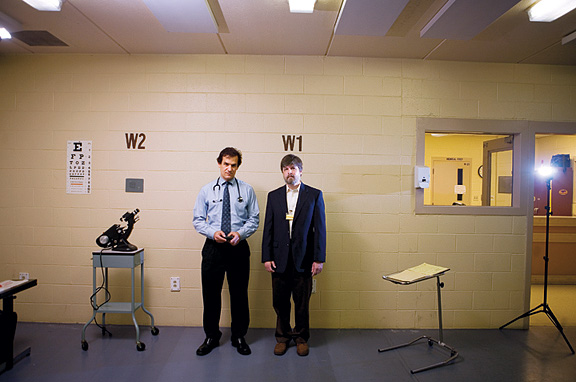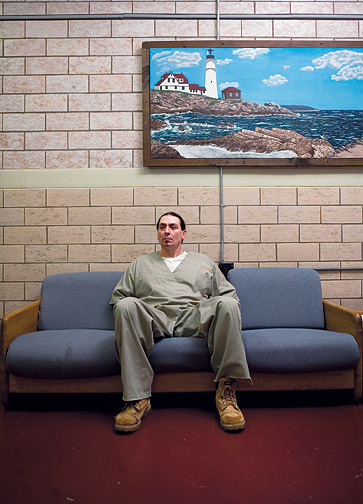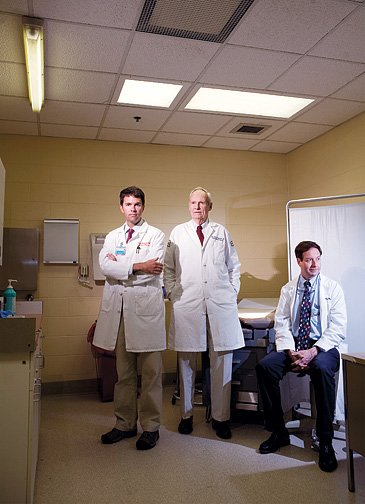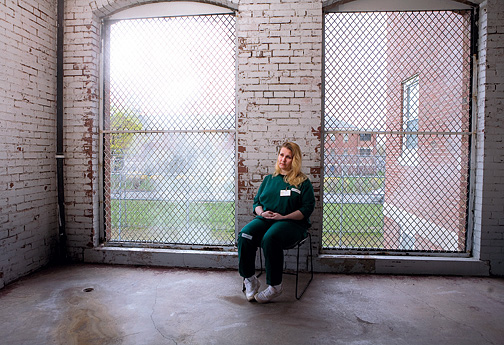On the second Tuesday in January, Professor of Medicine Josiah "Jody" Rich began his seventeenth year of weekly visits to Rhode Island's state prison, the Adult Correctional Institution (ACI). The first inmate he saw that morning was a familiar one.

Professor of medicine Jody Rich (left) and Associate Professor of Medicine Scott Allen have become advocates of prison reform as a result of their work studying the health of prisoners.
Long shook his head mournfully. "Way back," he said, his voice trailing off.
They talked inside a small examination room at the minimum-security prison on ACI's sprawling campus in Cranston. Rich, an infectious-disease specialist and professor of medicine and community health at the Warren Alpert Medical School, sat behind an old metal desk that supported an outdated computer. Long rested on a plastic chair next to an exam table. Nearby were a young resident and the prison's head nurse.
Laid low by drugs and sixteen prison stays in twenty-two years, Long, at sixty-one, was in bad shape. He had tested positive for HIV eighteen years earlier while incarcerated at the ACI, and the effects were catching up to him. His breathing was labored. He coughed frequently. His kidneys and heart were failing. His thin hair was arranged in cornrows above his small, weathered face, and his prison garb was a study in beige: beige sandals, beige flannels, and a light-beige thermal undershirt.
Inmates in Long's condition are not uncommon among the 2.3 million prisoners in the United States, a number that forty years ago was only 200,000. More than half of those 2.3 million have a history of substance abuse or mental illness. Thanks to mandatory sentences for even minor drug violations, and to the deinstitutionalization of the mentally ill, prisons have often become overcrowded warehouses mixing young and old, sick and healthy, hardened criminals with men and women guilty mostly of being foolish and young.
Not until 1976 did the U.S. Supreme Court rule that the Constitution guarantees prisoners the right to health care. Yet how that right is acknowledged varies greatly from state to state. Jody Rich is one of several Brown doctors who over the past quarter century have quietly established Rhode Island as a national model for providing quality health care to incarcerated citizens. From the treatment of HIV infection to the easing of addiction, Brown physicians like Rich have been not only on a mission to ensure that people who have broken the law get adequate health care; they have also used their prestige to advocate for better living conditions in prisons more generally.

Malek says that Rich and his collaborators have approached prisoner health care as a public health mandate, and have streamlined the transition of health care for prisoners as they are released back into the community. The doctors are, Malek says, "an example for the rest of the country."
In 2002, Rich received a pioneering five-year federal service grant that got prisoners off drugs like heroin and into methadone treatment paid for by Medicaid, a treatment that continues after a prisoner is released. The grant came about after Long was reincarcerated in the ACI nine years ago after he was convicted for possession of heroin. Rich believed that a prisoner put on methadone would be less likely to relapse after his or her release and therefore would be less likely to return to jail. Long, Rich says, "really inspired me to get that grant."
Sixty percent of inmates in Rhode Island are addicted to heroin, and the inmates in his grant were the toughest cases. Most had been severely dependent on heroin for more than a decade. Rich found that after they shifted to methadone, half the inmates stayed off heroin for at least six months. This convinced Rich that even chronic addiction can be treated, and he believed the way to understand the best addiction treatment would be to target addicts in the controlled environment of a prison and to monitor and care for them after their release.
Rich persuaded state prison administrators to allow inmates to detox on methadone over the course of four weeks or more, instead of the more common practice of only a few days. But addiction is not an easy problem to solve. Drug addiction, like diabetes, requires lifelong treatment. Methadone works with a majority of addicts, Rich says, but Long was not one of them.
"I've known you a long time," Rich said to him when they met again in January. "I've never seen your face so long."
As Rich concluded his exam, however, Long's spirits lifted.
"When am I going to see you again?" he asked with a smile.
Two months later Long was dead.
Similar stories echoed inside the concrete walls of the women's prison and the intake facility during the rest of Rich's day: the tearful young woman who had attended URI for microbiology but suffered from mental illness and drug addiction; the hulking construction worker with the forearm eagle tattoo who poured out his soul to Rich; the two middle-aged men with HIV who looked decades older, casualties of the crack epidemic in South Providence in the 1980s.
Rich considers many of these inmates less as bad people than as people with a disease. Not only do half of the nation's 2.3 million inmates have a history of substance abuse or mental illness; they have a much higher burden of such infectious diseases as HIV, hepatitis C, and tuberculosis. To researchers like Rich, having all these people in a controlled space makes them ideal test subjects for finding ways of breaking the cycle of addiction. "This correctional system has done us the favor of concentrating all these people right there," he says, "and all we need to do is add the treatment and we'll actually improve things. It's a public health and individual health opportunity."

Rich's affability belies a tireless work ethic. Having earned both an MD and a Master's in Public Health, he has published more than ninety peer-reviewed papers, mostly about the interplay between infectious diseases and addiction. In addition to his role at the ACI, he is a Brown professor and an attending physician at Miriam Hospital. Rich now has four NIH grants to study various HIV testing and treatment practices as well as to further refine methadone treatment.
His work at the ACI has turned Rich into an advocate for prisoners' rights. With his colleague Scott Allen '91 MD, a Brown associate professor of medicine, Rich oversees the nascent Center for Prisoner Health and Human Rights, which is based at Miriam. Rich argues that the nation's correctional system has become a warehousing system in which a cycle of recidivism takes root. "It's expensive, and often destructive and disruptive, and not helpful." Using his feet for emphasis, he says, "It's a sticky system. It's like tar paper; you step on it and you just can't get your feet out."
Rich has two goals: to use the prison system to develop better addiction treatments and to use the reputation of doctors to reform the system itself. "Physicians," he says, "have an opportunity and an obligation to advocate for reform in the system of corrections when the system conflicts with patient well-being."
Rich and Allen are part of a two-decade-long tradition of Brown physicians and students who have worked in Rhode Island prisons. "Correctional health care is part of community health care," says Professor of Medicine Tim Flanigan, who is director of the Division of Infectious Diseases at Brown's Warren Alpert Medical School and its teaching hospitals. "If you're not providing care in the corrections, you're not providing care to a big segment of your community."
It all started with two inmates dressed in orange jumpsuits.
In 1986, Professor of Medicine Charles Carpenter left his post as the dean of Case Western's medical school for Brown. Born in 1931 in Birmingham, Alabama, Carpenter graduated from Princeton and earned his medical degree from Johns Hopkins, where he worked for two decades.
Carpenter arrived in Providence just as HIV was beginning to spread. As an infectious diseases doctor, he saw a particular vacuum in the care of Rhode Island women with HIV, a majority of whom had acquired the virus through drug use. He resolved to see every woman in the state who was infected and to provide each of them with the best care possible at Miriam.
The next year, Carpenter received a call from a relative of a young woman with HIV who had attended an elite university but who'd become addicted to drugs and was imprisoned. The relative asked Carpenter if he would see this woman in the ACI. "I went down to see her and it was pretty distressing," he recalls. Accompanied by a social worker from Miriam, he saw two women with HIV that day. "We found them in a sort of outhouse away from the major building. They wore big orange jumpsuits with biological hazard signs on the back. Everybody was treating them pretty badly. And that was my introduction to the problem with the prison."
The experience changed Carpenter. State corrections officials granted him permission to treat inmates. This arrangement continued for two years. Then the department of corrections proposed that all prisoners receive HIV testing on their way in.
Carpenter felt uneasy. He feared that inside prison the knowledge of who was infected would carry an unforgiving stigma. He worried how guards and fellow inmates would treat infected prisoners. As the only medical school in the state, Brown could level significant clout against the proposal. So Carpenter proposed an alternative to the dean of the medical school: that Brown support testing provided Brown doctors could then treat infected prisoners. It was a Faustian bargain, Carpenter says, but created an ongoing partnership between Brown doctors and corrections officials that continues today.
Carpenter then recruited Flanigan, whose medical career had led him from Cornell to Penn to Case Western. He arrived at Brown in 1991. The week before he began teaching in the medical school, Carpenter asked him if he'd like to spend a half-day a week at the ACI. Nobody had ever mentioned such an idea to him before. "I had no idea what I was getting into," Flanigan says.
He still remembers vividly his first trip to the maximum-security prison. "You could lie on your bunk in maximum, put your arms out"—he acts this out—"and your elbows would touch the two walls. That's how wide it was. And you had a little steel toilet right there. That's it."
What impressed Flanigan, however, was the gratitude of his patients. They wanted to tell their stories. "Even though a lot of these men and women were 'hardened criminals,' they still wanted health care. And they did not want to be sick."
And so Flanigan and Carpenter tangled with the greatest medical epidemic in modern times, though today it seems easy to forget how deadly it was. Treatment could slow the disease but could not reverse it, as it can today. People generally died within eighteen months of diagnosis. "In 1991," Flanigan says, "we went to a lot of funerals."
At the time, 4 percent of male inmates and 12 percent of females were HIV-positive. One-third of the state's HIV-infected population lived in its prisons. This meant that Flanigan and Carpenter could not only treat inmates while they were incarcerated; they could also get them care at Miriam after their release. Flanigan and Carpenter were among the first to demonstrate that HIV testing in prison was fundamental to controlling a state's rate of infection. Doctors at Miriam now see more than 1,300 HIV patients, about three-quarters of all Rhode Island cases.
In the early 1990s Carpenter had hoped that other schools would follow Brown's lead. His chief resident at the time, Peter Dixon, published a paper arguing that medical schools were uniquely poised to care for prisoners. Carpenter says, "My idea was that all medical centers ought to take some responsibility for the prisoners in their locale." He saw it as a moral commitment. "Overall that's not been a clarion call that's been answered by everybody."

Rich realized that for treatment to be effective, he would have to become an advocate for changing social policy. At the time, possession of a syringe was a felony carrying a sentence of up to five years. Rhode Island was one of the few states in which more than half of its HIV cases came from dirty needles; by harshly punishing syringe possession, the state was encouraging their repeated use.
Rich sought support from the state's medical society and relentlessly lobbied every member of the state legislature. In 2000 Rhode Island finally legalized owning a syringe. Now any person can buy one at the discretion of a pharmacist. Inside his office, Rich digs into a desk drawer and pulls out an orange button with the slogan Clean Syringes Now.
"After we got that passed," he says, "injection-drug-use-related HIV transmission just dried up—not completely, but tremendously." According to state figures, in the last four years no woman newly diagnosed with HIV was infected by intravenous drug use, a complete reversal from two decades ago.
These days, Rich's research focuses on methadone use. Two of his current NIH grants focus on the subject. "Jody has spearheaded the efforts to go beyond HIV," Flanigan says. "And he is totally right. The worst epidemic in this country is not HIV, it's substance abuse."
Among the Brown medical students who would often accompany Flanigan and Rich on their visits to the ACI is Scott Allen, who would graduate at the top of his class. In October 1997, Anne Spaulding, the ACI's first official medical director, hired Allen as a staff physician. She had met Allen when she was doing her residency at Brown and he was a med student. "She said, 'I've got a job that has low pay, will probably get you sued, and people will wonder why you did it,'" Allen remembers. "Sign me up," he said.
It was not Allen's original plan. Three days before he and his wife Emma Simmons '91 MD, '04 MPH—she is now an assistant professor of family medicine—finished their residencies, their first child, Miles, was born with a very serious brain malformation. The news floored them.
"Within hours of our being told that he has problems," Allen recalls, "I thought, 'So much for an international health career, because he's not going overseas, and I'm not going without him. We have reshaped our lives around taking care of Miles. He changed my perspective on life."
This wasn't the first trauma Allen had faced. What he calls the "single most transformative experience" of his life happened when he was ten years old and a gas can exploded and left him with severe burns over about a third of his body. He spent part of his convalescence at the Shriners Burn Institute in Boston. As bad as his burns were, at Shriners he saw other patients with far more serious injuries.
"I became keenly aware," he says, "of the suffering of others in a way that a ten-year-old can never understand. A lot of what I have done is trying to make some sense of the world."
In October 1979, Allen, who was then seventeen, read news reports of Cambodian refugees fleeing the invading Vietnamese army, which ended the country's four-year-long genocide at the hands of Pol Pot. Allen felt he had to get over there. His parents called him crazy. He contacted a Thai relief agency, withdrew his $700 in life savings, and bought a one-way ticket to Cambodia for $550. He left his parents a note and flew to Bangkok.
Allen made his way to camps on the border with Thailand, where he listened to stories from those who had escaped the Khmer Rouge's torture and killing fields. Nine months later, overwhelmed, he returned home. He has returned often to Southeast Asia in the years since.
When Spaulding offered him the ACI position, Allen says he believed that American prisons weren't so different from refugee camps. In March 2002, Allen became the ACI's medical director. Allen has worked with Rich and Flanigan on pilot programs to treat hepatitis C, which is present in a third of inmates and was among the leading causes of death in prison. He published the first paper on treating the disease in prison.
In September 2004, however, Allen resigned over a disagreement with prison director A.T. Wall over what he viewed as a case of prisoner abuse. He was asked to review videotape of a prisoner who was forcibly removed from his cell by five officers and pepper-sprayed, knocked to the ground and struck. Allen argued that Wall should have disclosed the incident for public review.
"When I left prison and walked almost straight to Physicians for Human Rights," Allen says, "I stepped on a surfboard as a tsunami was rolling in."
That tsunami was the outcry over the treatment of Iraqi prisoners at Abu Ghraib. Allen joined Physicians for Human Rights in examining the Bush Administration's interrogation program, particularly the participation of health professionals. He reported on the causes of death of 112 detainees in U.S. custody in Iraq and Afghanistan and was one of the authors of a report on the likely criminality of U.S. personnel involved in the torture program.
His last report,"Experiments in Torture: Evidence of Human Subject Research and Experimentation in the 'Enhanced' Interrogation Program," was the first to document evidence of unethical human experimentation in the CIA interrogation program. It received international press attention, including mention in two New York Times editorials. It was cited by Discover magazine as one of the top 100 science stories of 2010.
Allen has testified before Congress and met with military officials. He appeared before the American Medical Association to advocate for strengthening physicians' obligation to refuse to participate in unlawful interrogation. Today, he splits his time among Physicians for Human Rights, Brown, and Eleanor Slater Hospital, in Cranston, where he is an attending physician in the mental health ward. He has arranged his hours so he can spend some time during each day with Miles, who is now sixteen, and his daughter Kari, who is nine.
In 2005, Allen and Rich founded the Center for Prisoner Health and Human Rights to "put a flag down," says Rich. Their hope is to gather a critical mass of expertise under one banner and become a resource for anyone with an interest in prisoner health. Last fall, they hired Brad Brockmann '76, a lawyer, activist, and graduate of the Episcopal Divinity School in Cambridge, Massachusetts, to oversee the center.
Allen recently went to Geneva to speak with Red Cross doctors about solitary confinement. He traveled to Libya on behalf of Physicians for Human Rights and Human Rights Watch to examine and attempt to negotiate the release of ailing dissident Fathi El-Jahmi. Allen and Rich journeyed to the Republics of Georgia and Armenia to help human rights groups there try to improve prison conditions. And Flanigan leads a team that's working on health care in the overcrowded prisons of Ghana. He has applied for a grant to do the same in South Africa.
Other states and universities are following Brown's lead, Allen says, to create collaborations between university medical schools and local prisons. State universities in Massachusetts, Connecticut, Georgia, and Texas have all carved out some kind of agreement, he says.
Allen and his colleagues continue to recruit new medical students and doctors to their cause. New work has begun to treat the larger group of released inmates who are not infected with HIV. Rich and Flanigan have been looking for six to eight residents to join them. One of these residents, Joe Frank, has spearheaded the proposal to get money to hire a community health worker.
When Frank interviewed for Brown's internal medicine residency program four years ago, he listened to Rich speak about the care of prisoners. Inspired, Frank said to himself, "That sounds like something I want to be a part of."
Ryan Goldberg is a writer based in New York City.




